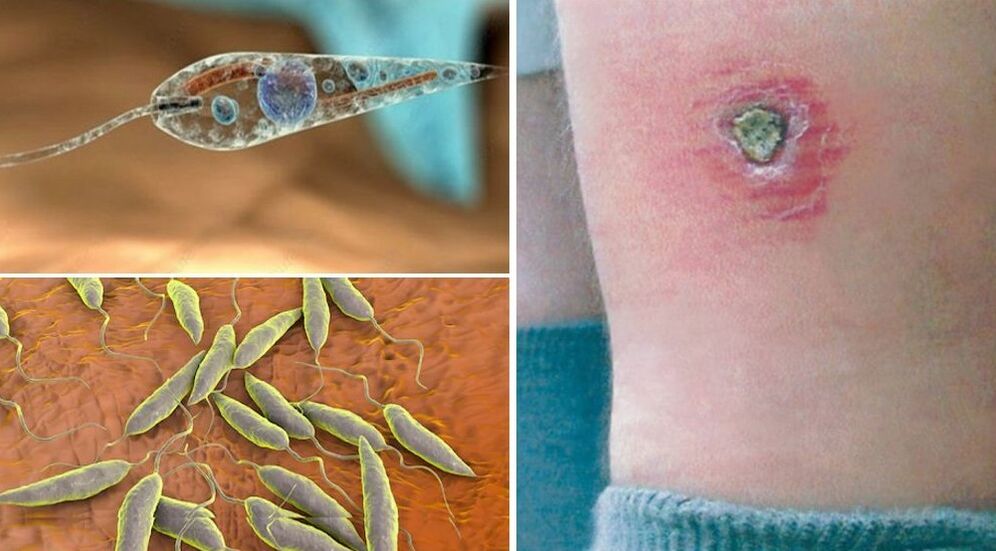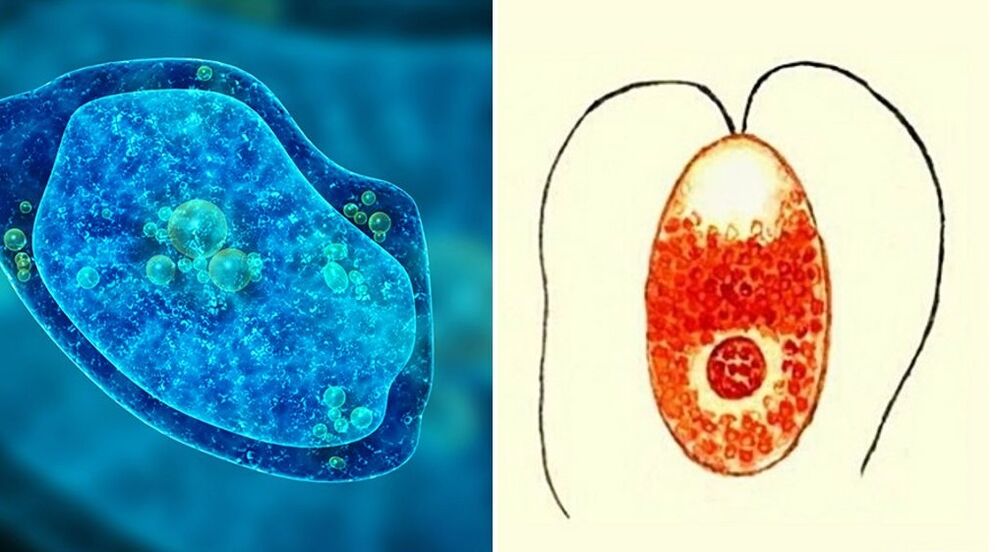Protozoan parasites in humans are pathogens of protozoan infections (or protozoa). These diseases are contagious, with serious complications and consequences. Therefore, protozosis requires timely diagnosis, accurate identification of the pathogen, and appropriate treatment.
What are protozoan parasites?
This is a group of unicellular microorganisms that are unable to produce nutrients on their own. They use other creatures throughout their lives, causing them serious illness. The following are the most common human protozoan parasites:
- flagella - giardia, leishmania, trichomonas, trypanosoma;
- sarcodal - dysentery amoeba;
- cilia - bursaria, balantidia;
- sporozoa - plasmodium malaria, coccidia, pyroplasms.
Trypanosoma
It is the simplest parasite that lives in the body of ungulates or infected humans. The carriers are the tse-tse flies that, when bitten by someone, inject saliva with protozoa into their skin.
In one comment!
About 400 trypanosomes need to be taken to develop the disease (African trypanosomiasis or sleep disorder). With a single bite of a fly, up to half a million parasitic individuals fall.
Characteristics of parasitism and diseases:
- trypanosomes circulate in the bloodstream of an infected person, causing trypanides on the skin (swelling of the face, eyelids), fever up to 40 ° C, swelling of the lymph nodes;
- then unicellular parasites migrate into cerebrospinal fluid, causing drowsiness, iridocyclitis, chronic fatigue, depression, speech and coordination disorders;
- the advanced form of trypanosomiasis is characterized by limb cramps, epileptic seizures, nervous and physical exhaustion, respiratory paralysis, coma, and death.
Romanovsky-Giemsa test, immunofluorescence test, enzyme immunoassay (ELISA), lymph node puncture are used to diagnose trypanosomiasis. Confirmation of the diagnosis is often done by donating the blood of a sick person to a laboratory pig. Treating sleeping sickness means taking special medications. In the absence of high-probability therapy, a fatal outcome for the patient is possible.
lamblia
Microscopic protozoa (synonyms - giardia or giardia) with four pairs of flagella are full-cycle parasites in the human body. They cause giardiasis under certain conditions. Giardiasis attach to the wall of the small intestine with a large heart, often settling in the channels of the liver, gallbladder, and other internal organs.
In one comment!
Infection with protozoa occurs with food, water, and unhealthy conditions. Giardia cysts containing embryos remain invasive in the environment for a long time (up to 3 months in freshwater and up to 4 months in wastewater). Diagnosis of protozoa is performed by microscopic examination of cysts and adults in the blood of the feces and detection of antibodies in the ELISA.
Leishmania
These flagellated protozoa cause leishmaniasis, a disease common in tropical and subtropical countries. The infection occurs in an infectious manner - in the case of biting saliva from blood-sucking insects and animals (dogs, ground squirrels). Mosquitoes, mosquitoes, flies, ticks can be carriers. There are two types of leishmaniasis in humans:
- skin and mucous membrane form (pendinskaya ulcer) - leishmania lives and multiplies in human skin, causing inflammation, swelling, ulcers, trophic ulcers, respiratory damage;
- visceral form - leishmania settles in the internal organs (spleen, liver, lungs, heart).
A characteristic sign of skin leishmaniasis is the formation of brown nodules (leishmaniomas) at the site of an insect bite. They are then replaced by round ulcers with difficulty healing and purulent discharge. The disease lasts for 1-2 years, leaving scars on the skin. In visceral form, leishmaniasis causes disorders of the adrenal glands, kidneys, liver, and spleen. They are found in the bone marrow, lymph nodes, skin scraping, and blood when diagnosing leishmania.

In one comment!
Treatment of leishmaniasis includes quarantine measures, patient isolation, and medication.
Trichomonas
These are the simplest parasites in the human internal environment, spreading from mother to child through sexual contact, domestic contact, or birth defects. Trichomonas has oral, intestinal, and urogenital varieties. Protozoa are the pathogens of trichomoniasis / trichomoniasis. Urogenital trichomoniasis of the urinary system is widespread. The chronic form of the disease threatens impotence and persistent infertility. Characteristics of Trichomonas parasitism:
- body size - up to 18 microns, moves fast due to mobile flagella;
- drug-resistant, determines the chronic course of trichomoniasis;
- they are rapidly destroyed in the environment, in the air, under direct sunlight;
- stay on a damp dishcloth, sponge, towel, soap dish for a long time;
- common infection during vaginal, oral-vaginal intercourse;
- Trichomonias contribute to the development of candidiasis, vulvitis, chlamydia, gonorrhea, cystitis.
The diagnosis of trichomoniasis involves the detection of Trichomonas in genital swabs. Treatment includes the use of medications, treatment with antiseptics. Therapy is performed on both partners to avoid relapses. Prevention of urogenital trichomoniasis includes measures recommended for all sexually transmitted diseases.
dysentery amoeba
This sarcode microorganism is a parasite that causes dangerous diseases in humans. There are two forms of dysentery amoebiasis - intestinal and extraintestinal (liver or pulmonary). The disease begins 7-10 days after infection with symptoms - bloody diarrhea, fever, vomiting.
In the absence of treatment, the consequences of amoebiasis develop - dehydration, fatigue, weakness, internal bleeding, liver abscess. The infection is most common via the oral-faecal route. The carriers of amoeba cysts can be insects - flies, flies. During diagnosis, tissue forms of protozoa are found in the stool. Treatment of amoebiasis is stationary using antibiotics.

Malaria Plasmodium
It is the representative of the simplest sporozoa, the causative agent of a dangerous disease - malaria. The human body serves as an incubator where the life cycle of the parasite takes place. Characteristics of parasitism:
- infection with plasmodium sporozoites occurs when a malaria mosquito bites;
- sporozoites enter the bloodstream through the saliva of an infected insect;
- sporozoites colonize the liver, invading its cells (hepatocytes);
- here merozoites are formed by mitotic replication;
- when hepatocytes are killed, merozoites invade erythrocytes;
- gamozocytes are formed from merozoites as a result of the sexual cycle;
- the mosquito becomes infected with gametocytes when it is bitten by an infected person;
- in the body of the mosquito, gametocytes become oocysts and then sporozoites;
- a mosquito infects a healthy person and the cycle repeats itself.
The destruction of erythrocytes and the entry of gametocytes into the bloodstream in humans is accompanied by febrile seizures, vomiting, anemia, convulsions and joint pain. In severe cases, the risk of death increases. Malaria is often relapsing, with phases of exacerbation and rest. Different protozoa cause tropical malaria, three days old and four days old. The main therapeutic and diagnostic agent is quinine - synthesized from natural cinchon or artificially.
Infusoria balantidia coli
This pathogen of balantidia (or infusory dysentery) lives in the colon and causes bleeding ulcers on its wall. Infection with protozoa occurs in domestic animals, mainly the carrier pig. Characteristics of anatomy and parasitism:
- the body of the balantidia is ovoid, with a dense, strong skin (pellicle);
- there are many cilia on the surface that serve movement;
- the sexual form of the parasite is required for multiplication by simple fission;
- asexual form (cysts) enters the environment with feces;
- The mode of human infection with cysts is oral-fecal.
Intestinal migration of protozoa in humans is accompanied by headache, vomiting, and dyspepsia. The acute stage of balantidiasis is a febrile condition, with signs of severe poisoning and loose stools with blood clots. Fatal outcome is possible if not treated in time.
Toxoplasma gondii
Microscopic crescent-shaped spore protozoa belonging to the order of coccidia are widespread in the environment. They are the cause of the disease - toxoplasmosis. In healthy people, ingested pests are killed by immune cells. Characteristics of the disease caused by human protozoan parasites:
- often toxoplasmosis is asymptomatic, immunity develops after recovery;
- the parasite affects the visual organs, the reproductive, nervous and lymphatic systems, the liver, the spleen;
- during pregnancy, toxoplasmosis causes severe congenital pathologies in the fetus or death;
- the acute form is associated with convulsions, paralysis, liver hypertrophy, heart problems;
- in case of chronic course, heart disorders and damage to the visual organs are possible.
The main hosts for protozoa are felines. In their bodies, oocysts form huge Toxoplasma colonies. Humans become infected through intermediate farming, nutritional, contact-household, or oral-fecal routes.






































